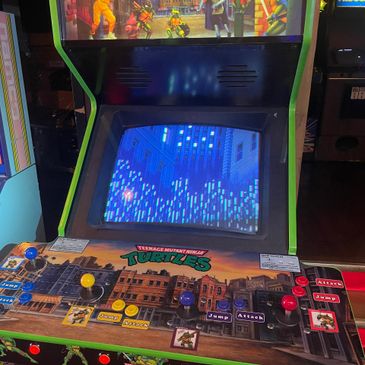Teenage Mutant Ninja Turtles - konami

Teenage Mutant Ninja Turtles
Teenage Mutant Ninja Turtles
Teenage Mutant Ninja Turtles

Coin Up
Teenage Mutant Ninja Turtles
Teenage Mutant Ninja Turtles
Press illuminated button on the character you wish to play, pressing the button for the number of lives you wish.

Start a Game
Teenage Mutant Ninja Turtles
Start a Game
Press either coloured button to begin play.
Developer: Konami
Year: 1989
Genre: Scrolling Fighter
Production: 34,000
Game Play
The player chooses from one of the four Ninja Turtles: Leonardo, Michelangelo, Donatello, and Raphael. Depending on the version of the game, the characters are either chosen via an in-game select screen or based on which coin slot the player placed their credit into. After Shredder kidnaps the Turtles' friend April O'Neil and their mentor Splinter, they must give chase, save their comrades, and defeat the evil Shredder. Up to four players (two in some versions) can take control of any of the Turtles. Donatello has slower attacks but a longer range, Michelangelo and Raphael have faster attacks but a shorter range, and Leonardo is a well-rounded Turtle with average range and speed.
The eight-way joystick controls the movements of the Turtle, the jump button makes them jump and the attack button makes them hit in front of them using their weapon. The Turtles can also perform special moves, including throwing Foot soldiers overhead and performing a special attack by pressing the jump and attack buttons; Raphael rolls along the ground and finishes with a kick, while the other Turtles do a sweeping jump attack with their weapons. The Turtles can also spring off the wall in certain areas. Enemies can be defeated more quickly by slamming them into walls or solid objects. Many objects such as traffic cones, parking meters, fire hydrants and exploding oil drums can be hit or damaged with attacks in order to help defeat nearby enemies. In the attract mode, the game shows the first part of the cartoon opening, along with a portion of the Teenage Mutant Ninja Turtles theme song.
Most of the enemies the Turtles face are the Foot Soldiers, all color-coded to indicate their attack patterns and weapon of choices. Some enemies, such as the standard purple-clad Foot Soldiers and Roadkill Rodney robots, have the ability to restrain the Turtles' mobility and drain their health, leaving only the player open to attack for other enemies. The bosses in the game include Rocksteady and Bebop (individually at first in that order, and later the two of them together), Baxter Stockman (in his human form), Granitor, General Traag, Krang, and Shredder himself.
History
The arcade game was a blockbuster hit, especially in North America, becoming Konami's highest-grossing arcade game. Konami was unable to keep up with high demand, so they outsourced additional US manufacturing production to Dynamo Corp. The release of the Teenage Mutant Ninja Turtles film in March 1990 gave the arcade game a further boost in earnings. By early April 1990, Konami had sold over 20,000 arcade cabinets internationally outside of Japan, including over 14,000 cabinets sold in the United States, where it became the biggest arcade hit since Double Dragon (1987). By early May 1990, the game had sold 25,000 arcade cabinets in America and Europe, with more units still in production to meet continued demand at the time.
In North America, Teenage Mutant Ninja Turtles was the highest-grossing upright cabinet on the RePlay arcade charts throughout 1990, from January through spring, summer and autumn to December. During November and December, weekly coin drop earnings averaged $163 per cabinet. It ended the year as the highest-grossing dedicated arcade game of 1990 in the United States, and it won a Diamond award from the American Amusement Machine Association (AAMA) for sales achievement in 1990.
The game was also a major hit in Europe, particularly the United Kingdom, where it was one of the top four highest-grossing arcade games during early 1990 (along with Tecmo World Cup '90, Super Masters and Line of Fire). On Hong Kong's Bondeal charts, Teenage Mutant Ninja Turtles was the top-grossing dedicated arcade game from December 1989 to January 1990. In Australia, the game was a record-breaking arcade hit in 1990 with high earnings during its first six months on the market, which was unusual for licensed arcade games which typically disappeared after several months. In Japan, Game Machine listed Teenage Mutant Ninja Turtles on their September 1, 1990 issue as being the fourth most-popular arcade game for the previous two weeks.